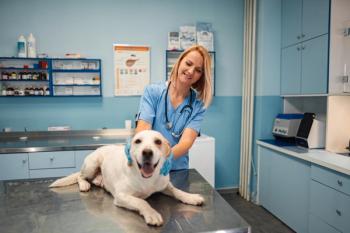
Interpreting dental radiographs (Proceedings)
Other than cost, one of the most commonly used excuses for not having a dental radiograph unit is the lack of information or training available on reading and diagnosing dental radiographs.
Introduction
Other than cost, one of the most commonly used excuses for not having a dental radiograph unit is the lack of information or training available on reading and diagnosing dental radiographs. Everybody can figure out what a tooth looks like, but how do you know something is wrong?
This lecture will first discuss the structures seen on the normal dental radiograph and then move into commonly seen pathology in the private practice. As with any procedure the more times you perform it or train on the topic, the better you will get at it and the more confident you will feel. Dental radiology is crucial to piecing together the diagnosis and subsequent dental treatment plan.
Film orientation and mounting
Since dental radiographs are small in size, there is no space to place a right/left marker. Dental film does come complete with a solution for that – the bubble or dimple. On digital systems, there can be square shape on the image. The bubble has two sides - convex and a concave. The convex side is the side that is facing the radiographic beam. There are two ways to use this bubble – 1) when the convex side of the beam is facing the examiner, you are essentially looking at the patient nose to nose, and 2) when you look at the film with the concave side of the bubble facing you, you are looking at the teeth from the inside of the patient's mouth looking out. Which ever way you choose, you must be consistent. Everyone at the clinic must agree on which side of the bubble to look at. The most commonly used method is the convex side up.
With the digital system, contact technical support to confirm film orientation.
Next, if you are looking at maxillary cheek teeth, the crowns should be pointing down and for mandibular cheek teeth the crowns should be pointing up. The cheek teeth should be positioned with the mesial teeth towards the center. Hence, knowing you dental anatomy is very important.
1→P4→P3→P2→P1→I3→I2→I1→Nose←I1←I2←I3←P1←P2←P3←P4←M1
Once your radiographs are dry, use film mounts – placing the films with the bubbles/dimples facing the same way (convex, concave) with the labial most teeth towards the center. Make sure they are labeled and dated so that you can monitor progress.
Normal anatomy
Dentin – The dentin is generally the radiopaque structures of the tooth
Pulp Chambe /Root Canal – The pulp chamber in the crown and the root canal in the root are the internal radiolucent structure that runs through the center of the tooth.
Periodontal Ligament – The periodontal ligament suspends the tooth to the alveolar bone. It appears as a radiolucent line between the tooth and the alveolar bone.
Alveolar Bone – The alveolar bone provides the socket where the tooth resides.
Lamina Dura – The lamina dura is cortical bone which lines the alveolus. The lamina dura appears as a radiopaque line between the periodontal ligament and the alveolar socket.
Mental foramina – The middle and posterior mental foramina are found on the buccal aspect of the mandible just apical to the second premolar and third premolar respectively. They are radiolucent and, depending on the angle of your x-ray beam, can be confused for an area of bone lysis. A solution for this problem is to reshoot the radiograph. The position of the foramina will shift with relation to the beam. The area of lysis will not move.
Symphysis – The symphysis is where the two sides the of the mandible meet. The joint is fibrous and presents as a thin, irregular radiolucent line between the two sides.
Mandibular Canal – The mandibular canal houses the nerves and vessels which supply the mandibular teeth. It is a radiolucent tube that runs along the ventral border of the mandible.
Palatine Fissures – The palatine fissures are located on the ventral rostral aspect of the maxilla. On radiograph they appear as two side-by-side radiolucent ovals with the radiopaque line of the nasal septum running between them.1
Examination of the dental radiograph
• Are you viewing the film with the correct side towards you?
• The correct tooth should be centered in the picture. Can you clearly see the structures of the tooth and surrounding bone?
• Does the crown surface or dentin have any abnormal lucencies or opacities?
• Do you have at least 2-3 mm of space/bone above and around the crown and around the roots?
• Does the crown have an area of dentin around the pulp chamber?
• When looking at the width of the pulp chamber, is the width the same when compared to the other teeth?
• Does the alveolar bone come up to the cementoenamel junction?
• Does the alveolar bone look consistent and clean?
• Is the periodontal ligament visible around the entire root?
Pathology
Periodontal disease
With periodontal disease, the alveolar bone level decreases as the inflammation moves apically and bone is resorbed. 40% of the bone has to be destroyed before bone loss can be visualized radiographically.2
Bone loss can be localized in one particular area or generalized where major sections of the crestal bone are involved. Bone loss can be horizontal where the alveolar marginal bone around adjacent teeth is decreased. Vertical bone loss appears as v-shaped alveolar bone defects on one or all roots.
Furcation exposure radiographically appears as an area of lucency due to loss of intraradicular bone.
Alveolar dehiscence appears as loss of the lamina dura, periodontal ligament space and alveolar bone all the way around the root.
Endodontic disease
In the diagnosis of periapical disease - a radiolucent halo in the periapical tissues can be the sign of an abscess.
Endodontic - Periodontic lesions start as primary endodontic lesions. A periapical lucency can be seen that extends coronally from the root apex eventually reaching the gingival sulcus. It has a J shaped lesion
Internal resorption occurs when there has been trauma or pulpal death through bacterial access through the vascular channels. The pulp has irregular or destroyed margins.
Odontoclastic Resorptive Lesions - areas of destruction to the dentin, pulp and root structure depending on the progression of the disease. There will be a loss of detail between the root and the bone due to ankylosis.
Chronic alveolar osteitis - This will generally be seen in cats. It appears as bone loss around the roots of the canines and expansile alveolar bone growth.
Malignant Oral Tumor - Anytime you have a mass in the oral cavity, a dental radiograph is warranted. Examination of the alveolar bone needs to be done to rule out malignancy. The alveolar bone can appear multilocular and honeycombed with indistinct borders and occasionally the teeth appear to be floating in the air.
Bone Sequestrum - Sequestras develop when a piece of alveolar bone is separated from the blood supply. Radiographically, you will see an area of bone surrounded by a radiolucent halo. The sequestered bone appears uniformly mottled.
Fractured Jaw/Tooth - On dental radiographs you are looking for radiolucent lines through the bone. The importance of dental radiographs with jaw fractures is to also help you find tooth roots that might possibly be involved.
Conclusion
For the veterinary technician, taking good quality radiographs is crucial. The technician is usually the one that looks at the radiograph first – checking technique and then alerting the doctor to any pathology seen. Once the diagnosis is made, the veterinary technician and the veterinarian can then properly and expeditiously prepare for the next phase of the treatment plan.
References
1. Mulligan TW, Aller MS, Williams, CA. Normal radiographic anatomy. In: Atlas of Canine and Feline Dental Radiography. Trenton: Veterinary Learning Systems, 1998, pp 68-90.
2. Bellows J. Dental radiography. In: Small Animal Dental Equipment, Materials And Techniques: A Primer. Ames: Blackwell Publishing, 2004, pp 63-103.
Newsletter
From exam room tips to practice management insights, get trusted veterinary news delivered straight to your inbox—subscribe to dvm360.






